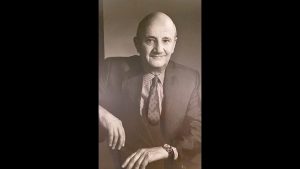Looking back on Nazi era in newly reissued novels from 1930s
Published July 14, 2021
There is no shortage of fiction set in the Nazi era being written today, and most serious attempts sit atop an enormous amount of historical research. This is in stark contrast to two novels written in the late 1930s and given new life by major U.S. publishers this year.
These are works that did not emerge from excavating the past, but which sprang from the urgency of their moment as history was unfolding.
“The Passenger” was written in the aftermath of Kristallnacht by Berlin native Ulrich Alexander Boschwitz when he was in his early 20s.
ADVERTISEMENT
The novel follows Otto Silbermann, a successful Jewish Berlin businessman and World War I combat veteran whose commitment to his country has prevented him from leaving, even as his son has found safe harbor in England. However, it is now late 1938, and Silbermann’s world is collapsing quickly. With the forced Aryanization of Jewish businesses, he is now dependent on the goodwill of non-Jewish friends and associates, only to find that they view his bad luck as an opportunity from which to benefit themselves.
 When Nazis come to the door of his apartment, Silbermann has little option but to escape through a back door. Unwanted or unsafe in hotels, he finds himself unexpectedly on the run and living largely on trains. He realizes “the fact is that I have already emigrated … to the Deutsche Reichsbahn. I am no longer in Germany. I am in trains that run through Germany.”
When Nazis come to the door of his apartment, Silbermann has little option but to escape through a back door. Unwanted or unsafe in hotels, he finds himself unexpectedly on the run and living largely on trains. He realizes “the fact is that I have already emigrated … to the Deutsche Reichsbahn. I am no longer in Germany. I am in trains that run through Germany.”
As he travels throughout the country scheming for money and freedom with increasing desperation, the time he spends in passenger compartments offers him the opportunity to take an inventory of attitudes toward Nazism and Jews among his compatriots. Most hold their party membership as a badge of honor.
Boschwitz does not idealize Silbermann. While he is admirable in not losing his moral sensibilities as the world around him has abandoned such niceties, he is also a fussy product of his social class. And he is stymied by his own stubborn belief in his country and what should be his rightful standing in it. He comes to understand his status more accurately only after it has evaporated: “I had a wonderful life … I was rooted … No, I wasn’t rooted. I only imagined I was.”
ADVERTISEMENT
Silbermann is able to travel with relative ease because he does not appear recognizably Jewish. And one of the book’s psychological insights emerges through Silbermann’s growing aversion to encountering fellow Jews, as they now present a risk to him. Running into an old friend, he notes that “I, too, was afraid of his Jewish nose.”
When I saw that Boschwitz died in 1942, I assumed that he had been killed in the Holocaust. His fate was more complicated. He was born to a Protestant mother and a Jewish father who had converted to Christianity, but who died shortly before Ulrich’s birth. Boschwitz, who was still a Jew by Nazi standards, and his mother were able to leave Germany in 1935, eventually settling in England.
He published a version of “The Passenger” there in 1939. However, with the onset of World War II, he, along with many refugees from Nazi Germany, were classified as “unfriendly aliens.” He was shipped off to camps, first on the Isle of Man and then in Australia. Upon being reclassified as “friendly,” he was returned to England on a passenger ship that was torpedoed by the German Navy. He died along with 361 other passengers.
Kathrine Kressmann Taylor’s “Address Unknown” is a book I had heard of but never encountered. The short work was originally published in 1938 in the magazine “Story,” where it was credited simply to Kressmann Taylor — apparently, the magazine’s editor and Taylor’s husband felt that the piece was “too strong to appear under the name of a woman.”
 It was soon published as a book by Simon and Schuster (still under the pseudonym) to great success, but has spent most of the ensuing decades out of print. It has been reissued this summer by Ecco.
It was soon published as a book by Simon and Schuster (still under the pseudonym) to great success, but has spent most of the ensuing decades out of print. It has been reissued this summer by Ecco.
Born in Oregon, Taylor (who was not Jewish) wrote the book while living in San Francisco. She did so in response to witnessing good friends of hers in the United States return to their native Germany and transform into committed Nazis.
The 96-page novella consists entirely of letters sent between Martin Schulse and Max Eisenstein, partners in a San Francisco art gallery, after Martin returns to Germany in the early 1930s. Over the course of their correspondence, which begins with great mutual affection, we witness Martin’s emerging adoption of Nazism, along with the corresponding unhappiness voiced by Max, who is Jewish.
Max’s alarm is heightened by concern about the welfare of his Viennese sister (with whom Martin had once engaged in an affair), who is attempting to pursue a career as an actress in Berlin. And I will stop here, as it would be unfair of me to reveal more of the plot of this satisfying, but very short book, other than to say that Taylor used the letter-writing device brilliantly.
Both of these books are timely, given the current rise of antisemitism and an increase in racist violence, particularly directed against Asian Americans. And what I find especially resonant in both books is their focus on relationships as a barometer of societal dysfunction. These portraits of how opportunism, ideological devotion and bigotry can trump friendships and interpersonal loyalties are all too real, and they are warnings to heed.
“The Passenger” by Ulrich Alexander Boschwitz (288 pages, Metropolitan Books)
“Address Unknown” by Kathrine Kressmann Taylor (96 pages, Ecco)
Editorial: Good News is No News
“The time has come,” the Walrus said, “To talk of many things: ADVERTISEMENT Of shoes – and ships – and sealing-wax – Of cabbages – and kings – And why the sea is boiling hot – And whether pigs have wings.” — Lewis Carroll, The Walrus and the Carpenter, from Through the Looking Glass and…
A Transformative Journey – Forrest Channing Hunter
Editor’s Note: Forrest Channing Hunter, a student at Governor French Academy in Illinois and a member of Cultural Leadership’s Class Seven, wrote the following poem after visiting the United States Holocaust Memorial Museum during the 20-day Cultural Leadership summer trip. ADVERTISEMENT “Not Another Night, Not Another Star” By Forrest Channing Hunter All aboard…
A Transformative Journey with Cultural Leadership – Melinda Oliver
I’ve always been aware of my identity as a young, African-American girl growing up in St. Louis. I was taught my place and the guidelines of this city before I even began my first day of middle school. I knew what typically was, and almost undeniably still is, the image of a girl like me…
Shir Hadash Reconstructionist Community relocates to JCC Staenberg Family Complex
Shir Hadash Reconstructionist Community, St. Louis’ only Reconstructionist congregation, is relocating to the Jewish Community Center’s Staenberg Family Complex Arts & Education Building, 2 Millstone Campus Drive in Creve Coeur. The congregation’s first program in its new home was a summer Torah study in the Beit Midrash room on July 9. Upcoming events include a…
Jewish Federation seeks award nominations
The Jewish Federation of St. Louis is now seeking nominations for the Fred A. Goldstein Memorial Service Award given annually to recognize outstanding professional service. The award has been given since 1965. Nominees must be employed by a St. Louis Jewish organization and currently working in any direct service, professional or managerial role. Nominations should…
















